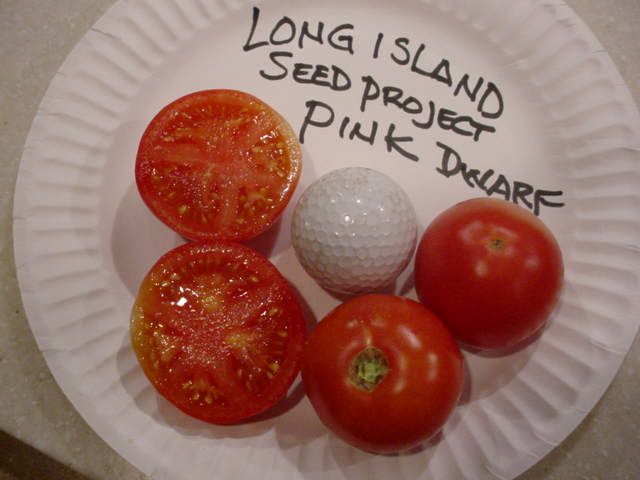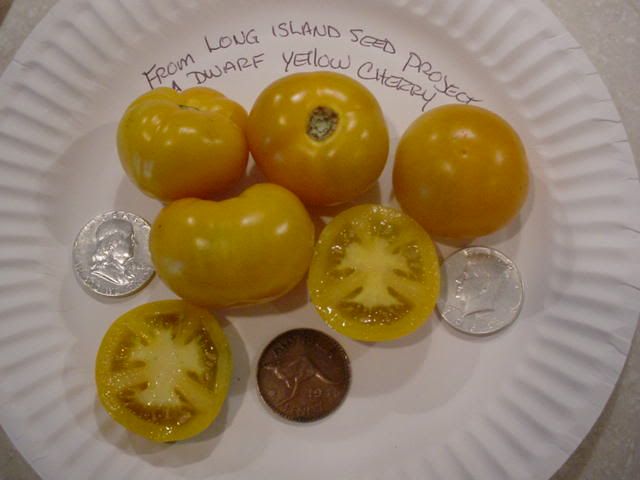|
|
Post by Alan on Apr 16, 2007 20:32:04 GMT -5
|
|
|
|
Post by flowerpower on Apr 17, 2007 23:10:30 GMT -5
Read through their seed lists. Alot of the hybrid descriptions give the history of all the varieties they crossed. It's pretty interesting reading.
I did get some seeds for the dwarf tomatoes. I just started them today in fact. I have Red, Gold, Yellow, Pink & Red "Bullet Shaped". I thought alot of the pumpkins and squash looked interesting.
|
|
|
|
Post by bluelacedredhead on Apr 18, 2007 20:05:39 GMT -5
AS you know FP, I thought the same as you in regards to the Squashes. Just not interested enough to join their group.
|
|
|
|
Post by flowerpower on Apr 19, 2007 6:22:37 GMT -5
I'm sure I have enough squash & pumpkin varieties to conduct my own experiments. I am always playing with the gourds. I've gotten some interesting things. Last yr I had a nice sized green, striped- pear. Some were as big as grapefruits.
|
|
|
|
Post by johno on Apr 19, 2007 13:08:49 GMT -5
I am also fascinated particularly with their squash breeding. I only found a couple of things that seem well suited for my climate, otherwise I'd join and get some seeds.
This theme of intentionally allowing crossbreeding has come up here a few times already. In a way, I think it is just as important an endeavor as keeping heirloom lines pure. It is an "heirloom" method; the Indians, and surely peoples all over the world, have done it since the dawn of time. It celebrates natural selection.
|
|
brook
gardener
  
Posts: 127
|
Post by brook on Apr 19, 2007 13:47:45 GMT -5
There's one problem with natual crossbreeding. Once you find a "new" variety that you like, it can take seven years to stabalize it. Seven years, lots of room, and not much else growing in the gardens.
Some day I'll tell all y'all about the great pumpkin experiment, and why it didn't work out.
|
|
|
|
Post by johno on Apr 19, 2007 14:03:21 GMT -5
The suspense is kiling me  I want to hear the story! Finding a new variety is definitely interesting, but what about using, say three C. moschatas, for example, and just letting them cross as they may, saving the seeds every year, and sticking with that gene pool - not looking to purify a new line? This is done traditionally in the southwest, according to native seeds/SEARCH (although not necessarily with moschatas...) I use moschatas as an example because I'm considering doing this with Seminole pumpkin, Sucrine du Berry, and an as of yet undetermined third, possibly Greek Sweet Red. These are among the only ones with enough insect resistance to get a good crop reliably here. I do have plenty of room - up to two hundred acres if it weren't partially wooded. |
|
brook
gardener
  
Posts: 127
|
Post by brook on Apr 19, 2007 16:06:20 GMT -5
Well, obviously, my orientation is the opposite. I'm dedicated to preserving existing varieties. So my first question, really, is why do that? With all that room, you could easily maintain purity while still providing a diversity of squashes.
I also find it difficult to believe that among more than a hundred named moschatas only three will grow reliably by you.
Now I'm going to get socratic, and just ask questions, cuz I don't have the answers.
1. How long before the total genetic mix of the three varieties stops producing new combinations, and self-stabalizes into a single variety? Seven years? A hundred years? Never?
2. Repeating my above questions, what happens if one of the new combinations is particularly appealing to you? Do you try and stabalize it; or just let it run, and lose it? Conversely, what if most of the new combinations are not appealing in size, shape, color or taste (there's no guarantee they will be). What's your fall-back position?
As to the great pumpkin story, that'll have to wait until I feel up to typing it out. It's rather long.
|
|
|
|
Post by Alan on Apr 19, 2007 20:14:49 GMT -5
This conversation is very interesting to me and I hope to see it continue. I see it both ways. If something is increadibly rare, then yes, untill seed increase and distribution is done, then keep it pure. However, if you have the extra seed and a variety that has been shared with the world, then I can understand throwing three or four varieties together as to have a wider genepool in a concise growing area, much as the native americans in the southwest did.
liseed did answer my prayer about OP corn.
It seems to be that their solution is to plant like genus corns (su, sh, sh2) together, 3-4 varieties at a time, with similar maturity dates, let them cross and save seed, they will continue to segregate and hybridize over years, my guess would be that it is probably wise to throw in some new stock every 3 or 4 years or so. That is something I am going to experiment with.
I was really interested in their cheese squash story and Brook I would love to hear about the big pumpkin project when and if you have time soon.
-Alan
|
|
|
|
Post by Alan on Apr 19, 2007 20:19:04 GMT -5
Brook, I may have an answer to your two questions
1. Looking at some of the southwestern native american squash varieties it seems like quite possibly as long as no one type in particular is selected out over time, and seed is saved from multiple types, as long as there are enough genes still circulating in the pool, that this segregation can continue on for an indeterminate amount of time
2. If I found something I particularly liked, I would probably try to keep it and stabilize it. If none of the recombiants are likable, I would drop it as an experiment, but then again I will always have a field of "market ready" stuff. I think it just depends on the rarty of the seed, amount of time you want to put in it, and the amount of space you have.
|
|
|
|
Post by PapaVic on Apr 21, 2007 19:53:08 GMT -5
I did get some seeds for the dwarf tomatoes. I just started them today in fact. I have Red, Gold, Yellow, Pink & Red "Bullet Shaped. Flower, You should have discovered the viability of the dwarf seeds I sent you by now as I also sowed some of the same types on Sunday, April 15, and already have seen near 100% germination. The Bullet Shaped and Pinks came up first (100%) with the yellow following in a day or two (over 75%). I didn't start any gold or red this year, so we're counting on you for lots of fresh seeds! I wish I had sent you some Pixie Peach with those others ... they also showed 100% germination and are arrow straight. BTW, I use a heat pad and put heavy 24/7 florescent light on the first indication of sprouts, and then back off the lights to 16 - 18 hrs. a day after the first true leaves begin peeping out between the cotyledons. Keep us posted on the Long Island Dwarves. Bill |
|
|
|
Post by bluelacedredhead on Apr 21, 2007 20:33:53 GMT -5
Alright, now you've got my interest piqued..I'm hoping that Flowerpower will have some fruit from these dwarf varieties to taste when we get together in the Syracuse,NY area come the end of July...
|
|
|
|
Post by PapaVic on Apr 22, 2007 8:01:29 GMT -5
Mr. Ettlinger sent me a packet of about 30 seeds last winter. They were marked "mixed" and so I planted about half of them to try and get as many different kinds as were in the mix. Then I attempted to pick out some seedlings that looked different from one another hoping to increase my chances of having all the different types in the garden. That was a crap shoot as many of them looked identical as seedlings. Anyway ... I grew 20 plants and ended up getting five types: Red, Pink, Yellow, Gold, and a single plant with Red Bullet Shaped fruit. There's supposed to be a green when ripe type in the mix as well, but I did not get it out. All types grew on short, bushy, rugose, healthy plants that loaded up with fruit. I thought the Yellow tasted the best as it was sweet, tart, and popped when you bit it. Lovely. The Pink is okay too and I hope to cross it with a large pink Russian tomato this summer and grow out some dwarf or determinate progeny over the next five or six years. Here's a link to the page explaining Long Island Seed Project's dwarf seed mix history: www.liseed.org/rambl_newoldtomato.htmlI sent back over half the saved seeds to Mr. Ettlinger this winter as he was very interested in the Red Bullet Shaped one and said he had not noticed that in his grow outs yet. I hope it comes back true to that shape as it was cute and interesting like a little "grape paste" or something. Here are some photos of three types. I guess I wasn't impressed with the red dwarf as I don't seem to have any pics of it ... and I don't know why I don't have a pic of the Bullet Shaped dwarf 'cause I did want to continue growing it out.  ^Long Island Seed Project Gold Dwarf^  ^Long Island Seed Project Pink Dwarf^  ^Long Island Seed Project Yellow Dwarf^ Bill |
|
|
|
Post by bluelacedredhead on Apr 22, 2007 20:52:03 GMT -5
Personally, I like the looks of the Pink and the Yellow.
The core of the Gold Dwarf gives the appearance of being pithy or hard?? Don't know if that's the case, but it just looks that way in the picture..
I like the colour of the pink, and the yellow appears to have few seeds??
Keep the pics and the info coming. I'm intrigued by this project for sure.
|
|
|
|
Post by bluelacedredhead on Jul 15, 2007 21:59:25 GMT -5
I went to the LISP site to look thru their catalogue. Seems they have taken it off the web as they are finished with seed sales for 2007...
Does anyone know when they start selling again??
|
|